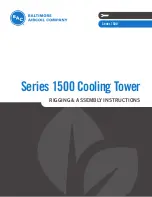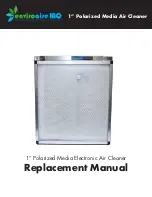
11
Use the canvas duct for connecting the indoor unit and the duct. (Fig. 9-1)
Use fireproof material for the duct parts.
Make sure that the duct has sufficient heat insulation.
A
Electrical parts box
B
Canvas duct
C
Air outlet flange
D
Air outlet duct
E
Filter (Accessory)
F
Air outlet grille
G
Air intake grille
H
Ceiling
I
Drainage pan
J
Air intake
K
Air outlet
L
Allow clearance to avoid short cycling.
M
Indoor unit
N
Earth terminal
O
Earth cable
P
850 mm or more
Q
Safety net (procured locally)
Notes:
•
The fan and motor are dangerous if handled during operation. For this
reason, be sure to install the indoor unit at least 850 mm from the air intake
grill
G
.
If it is not possible to put more than 850 mm of distance between the air
intake grill and the indoor unit, install the safety net
Q
(locally procured).
•
Connect the main body of the air conditioner and the duct so that their
potentials are equal.
•
Connect an earth cable
O
from the air outlet flange
C
to the earth terminal
N
. Then, connect another earth cable
O
from the earth terminal
N
to the
air outlet duct
D
.
•
Be sure to install an air filter (procure locally) and an air outlet duct.
9. Duct work
In case of rear-side suction
In case of bottom-side suction
Fig. 9-1
10.1. Before test run
s
After completing installation and the wiring and piping of the indoor and
outdoor units, check for refrigerant leakage, looseness in the power supply
or control wiring, wrong polarity, and no disconnection of one phase in the
supply.
s
Use a 500-volt megohmmeter to check that the resistance between the power
supply terminals and ground is at least 1.0 M
Ω
.
s
Do not carry out this test on the control wiring (low voltage circuit) termi-
nals.
Warning:
Do not use the air conditioner if the insulation resistance is less than 1.0 M
Ω
.
Insulation resistance
After installation or after the power source to the unit has been cut for an extended
period, the insulation resistance will drop below 1 M
Ω
due to refrigerant accumulat-
ing in the compressor. This is not a malfunction. Perform the following procedures.
1. Remove the wires from the compressor and measure the insulation resistance of
the compressor.
2. If the insulation resistance is below 1 M
Ω
, the compressor is faulty or the resist-
ance dropped due the accumulation of refrigerant in the compressor.
3. After connecting the wires to the compressor, the compressor will start to warm
up after power is supplied. After supplying power for the times indicated below,
measure the insulation resistance again.
•
The insulation resistance drops due to accumulation of refrigerant in the com-
pressor. The resistance will rise above 1 M
Ω
after the compressor is warmed
up for two to three hours.
(The time necessary to warm up the compressor varies according to atmos-
pheric conditions and refrigerant accumulation.)
•
To operate the compressor with refrigerant accumulated in the compressor,
the compressor must be warmed up at least 12 hours to prevent breakdown.
4. If the insulation resistance rises above 1 M
Ω
, the compressor is not faulty.
Caution:
• The compressor will not operate unless the power supply phase connection
is correct.
• Turn on the power at least 12 hours before starting operation.
- Starting operation immediately after turning on the main power switch can result in
severe damage to internal parts. Keep the power switch turned on during the op-
erational season.
10.Test run
B C
N
A
M
E
P
H
G
L
J
K
F
I
D O
Q
E































